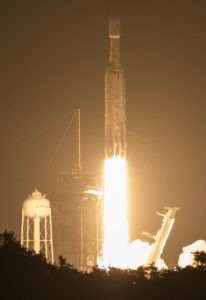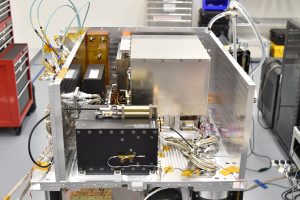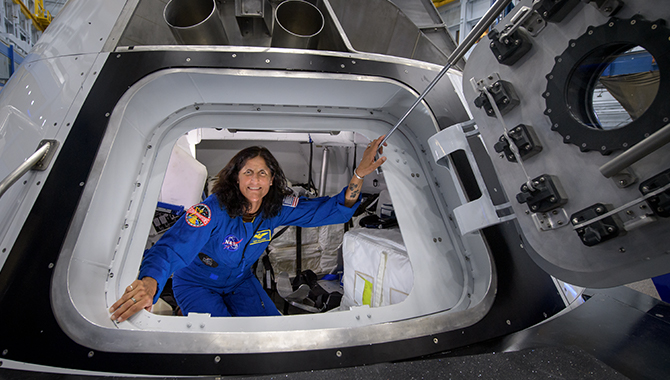
An engineer with Ball Aerospace performs final checks on NASA’s Green Propellant Infusion Mission before the spacecraft was shipped to NASA’s Kennedy Space Center in Florida for launch processing.
Credit: Ball Aerospace
Missions have dramatic potential implications for deep space exploration.
In the early morning of June 25, SpaceX launched a Falcon Heavy from Launch Complex 39A at the Kennedy Space Center in Florida, carrying technologies from NASA with the potential to reshape deep space exploration. Space Test Program-2 (STP-2) will deliver 24 satellites to space for the U.S. Department of Defense, the National Oceanic and Atmospheric Administration and other partners.
NASA sent four technology missions into space aboard the Falcon Heavy, the most powerful rocket currently in use today, standing 229.6 ft tall, with a mass of 3,125,735 lb. These missions will return important data to validate promising technologies crucial for future exploration of deep space.
“These technologies can enable autonomous navigation for deep space missions beyond the reach of our global positioning system, provide a non-toxic green propellant to replace current highly toxic chemical propulsion systems, help us understand irregularities in the upper atmosphere that can interfere with GPS and communication signals, and help us better understand how to protect our spacecraft from the harmful space environment effects,” said Jim Reuter, acting associate administrator of NASA’s Space Technology Mission Directorate, during a teleconference earlier in the month to discuss the missions.

A SpaceX Falcon Heavy rocket launches from Launch Complex 39A, Tuesday, June 25, 2019 at NASA’s Kennedy Space Center in Florida.
Credit: NASA/Joel Kowsky
“…We anticipate the technologies and the science instruments on this launch will improve the design and performance of future spacecraft, supporting exploration of the Moon, Mars, and beyond, while also supporting important commercial applications,” Reuter said.
The missions cover a broad spectrum of deep space exploration issues, and it took a coordinated effort to bring them together for this launch. The Green Propellant Infusion Mission (GPIM), for instance, has been in development for almost two decades. Testing the propellant in space for the first time is a milestone and could be the validation needed to put it on spacecrafts, perhaps within 18 months.
The propellent is AF-M315E, a Hydroxyl Ammonium Nitrate fuel/oxidizer blend. The U.S. Air Force Research Laboratory at Edwards Air Force Base in California developed this high-performance, green alternative to hydrazine. AF-M315E is much less toxic than hydrazine and although it is still an explosive, it is much safer to store and handle. Ball Aerospace developed the test vehicle, a BCP 100, which is about the size of a mini refrigerator, employing thrusters developed by Aerojet Rocketdyne.
AF-M315E is denser and has greater viscosity than hydrazine, which means a similar volume provides about 50 percent more total impulse. It is also safe enough to handle that technicians don’t need to wear pressurized escape suits. It could enable research labs to fuel their own satellites before shipping to a launch facility, which would reduce project costs.
“One of the nice things about the AF-M315 propellant we are using is that it goes through a glass transition, rather than freezing,” said Christopher McLean, principal investigator for GPIM at Ball Aerospace. During mission studies, the team examined not using heater power when on the south pole of Mars. “So, you can take that power, put it into … the science payloads, so there’s more power available over all … that would historically be used for keeping just the fluids warm over time.”
Developing a propellent system using AF-M315E held its share of challenges. Because this class of fuels is based on ionic salts, the combustion temperature is about twice that of hydrazine, McLean explained. “Really, since this is a mono propellant, this looks a lot like a standard hydrazine mono propellant technology, except the material demands are extreme. I think why these were not implemented sooner was really a materials survivability issue,” McLean said.

The Atomic Clock, GPS Receiver, and Ultra-Stable Oscillator which make up the Deep Space Atomic Clock Payload, following integration into the middle bay of Surrey Satellite US’s Orbital Test Bed Spacecraft. Credit: Surrey Satellite Technology
Another NASA technology mission aboard the launch was the Deep Space Atomic Clock, which holds the potential to unlock autonomous navigation for deep space missions. The clock was developed by a team at NASA’s Jet Propulsion Laboratory.
Currently, to discern a spacecraft’s position in space, navigators send a signal to it and precisely time an echo of that signal sent back to Earth. Jill Seubert, deputy principal investigator for the Deep Space Atomic Clock, likens the process of guiding a spacecraft this way to shooting an arrow in California and attempting to strike a quarter in New York’s Times Square.
“Tracking a spacecraft as it travels through space is fundamentally a problem of measuring time,” Seubert said in the teleconference.
This two-way tracking signal process is required because the clocks onboard spacecraft don’t have the extreme accuracy required to precisely locate them as they travel through deep space, thousands of miles per hour. It can take hours to complete one cycle.
Historically, clocks with the precision needed have been about the size of a large refrigerator, too large to accommodate on most spacecrafts. The new Deep Space Atomic Clock is much smaller—about the size of a toaster—and startlingly accurate, expected to lose no more than one second in 9 million years.
“Now, with this capability, we can transition to what we call one-way tracking, in which the tracking signal goes directly from the spacecraft to the Earth, or vice versa from Earth to the spacecraft. One-way tracking with a high accuracy clock is a much more efficient and flexible way to track a spacecraft and it’s a better way to navigate deep space,” Seubert said.
Don Cornwell, director of the Advanced Communications and Navigation Division of NASA’s Space Communications and Navigation program, likened the advance to when 17th century clockmaker John Harrison developed the Marine Chronometer, solving the problem of calculating longitude at sea.
“NASA’s Deep Space Atomic Clock will revolutionize navigation in deep space,” Cornwell said. One-way tracking means fewer uploads of time corrections. Spacecraft can have great autonomy, while freeing capacity on NASA’s Deep Space Network for more down linking of science data.
Other technologies aboard the launch will study how bubbles in the Earth’s ionosphere distort radio signals, and ways to better protect spacecraft from the harmful effects of the space environment.
“These multi-use technology demonstrations and science instruments will feed our future NASA missions as we establish a sustainable lunar presence through the Artemis program and journey onto Mars,” Reuter said.









